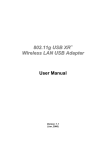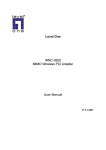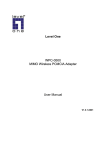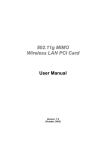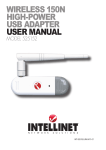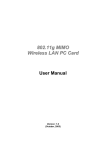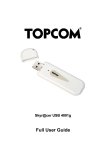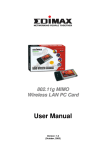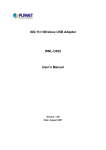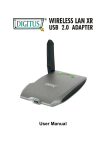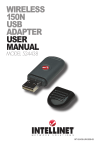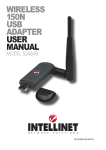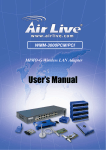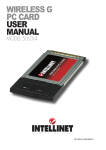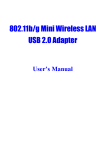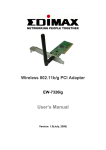Download 802.11g Wireless USB 2.0 Adapter WL-U356R User`s Manual
Transcript
802.11g Wireless USB 2.0 Adapter WL-U356R User’s Manual Copyright Copyright © 2006 by PLANET Technology Corp. All rights reserved. No part of this publication may be reproduced, transmitted, transcribed, stored in a retrieval system, or translated into any language or computer language, in any form or by any means, electronic, mechanical, magnetic, optical, chemical, manual or otherwise, without the prior written permission of PLANET. PLANET makes no representations or warranties, either expressed or implied, with respect to the contents hereof and specifically disclaims any warranties, merchantability or fitness for any particular purpose. Any software described in this manual is sold or licensed "as is". Should the programs prove defective following their purchase, the buyer (and not PLANET, its distributor, or its dealer) assumes the entire cost of all necessary servicing, repair, and any incidental or consequential damages resulting from any defect in the software. Further, PLANET reserves the right to revise this publication and to make changes from time to time in the contents hereof without obligation to notify any person of such revision or changes. All brand and product names mentioned in this manual are trademarks and/or registered trademarks of their respective holders. Federal Communication Commission Interference Statement This equipment has been tested and found to comply with the limits for a Class B digital device, pursuant to Part 15 of FCC Rules. These limits are designed to provide reasonable protection against harmful interference in a residential installation. This equipment generates, uses, and can radiate radio frequency energy and, if not installed and used in accordance with the instructions, may cause harmful interference to radio communications. However, there is no guarantee that interference will not occur in a particular installation. If this equipment does cause harmful interference to radio or television reception, which can be determined by turning the equipment off and on, the user is encouraged to try to correct the interference by one or more of the following measures: 1. 2. 3. 4. Reorient or relocate the receiving antenna. Increase the separation between the equipment and receiver. Connect the equipment into an outlet on a circuit different from that to which the receiver is connected. Consult the dealer or an experienced radio technician for help. FCC Caution To assure continued compliance. (example-use only shielded interface cables when connecting to computer or peripheral devices). Any changes or modifications not expressly approved by the party responsible for compliance could void the user’s authority to operate the equipment. This device complies with Part 15 of the FCC Rules. Operation is subject to the Following two conditions: ( 1 ) This device may not cause harmful interference, and ( 2 ) this Device must accept any interference received, including interference that may cause undesired operation. Federal Communication Commission (FCC) Radiation Exposure Statement This equipment complies with FCC radiation exposure set forth for an uncontrolled environment. In order to avoid the possibility of exceeding the FCC radio frequency exposure limits, human proximity to the antenna shall not be less than 20 cm (8 inches) during normal operation. R&TTE Compliance Statement This equipment complies with all the requirements of DIRECTIVE 1999/5/CE OF THE EUROPEAN PARLIAMENT AND THE COUNCIL OF 9 March 1999 on radio equipment and telecommunication terminal Equipment and the mutual recognition of their conformity (R&TTE) The R&TTE Directive repeals and replaces in the directive 98/13/EEC (Telecommunications Terminal Equipment and Satellite Earth Station Equipment) As of April 8,2000. Safety This equipment is designed with the utmost care for the safety of those who install and use it. However, special attention must be paid to the dangers of electric shock and static electricity when working with electrical equipment. All guidelines of this and of the computer manufacture must therefore be allowed at all times to ensure the safe use of the equipment. EU Countries Intended for Use The ETSI version of this device is intended for home and office use in Austria Belgium, Denmark, Finland, France (with Frequency channel restrictions). Germany, Greece, Ireland, Italy, Luxembourg .The Netherlands, Portugal, Spain, Sweden and United Kingdom. The ETSI version of this device is also authorized for use in EFTA member states Iceland, Liechtenstein, Norway and Switzerland. WEEE regulation To avoid the potential effects on the environment and human health as a result of the presence of hazardous substances in electrical and electronic equipment, end users of electrical and electronic equipment should understand the meaning of the crossed-out wheeled bin symbol. Do not dispose of WEEE as unsorted municipal waste and have to collect such WEEE separately. Revision User’s Manual for PLANET 802.11g Wireless USB Adapter Model: WL-U356R Rev: 1.0 (February 2006) Part No. EM-WLU356R CONTENTS 1 INTRODUCTION ...................................................................... 1 1.1 Features ......................................................................................................... 1 1.2 Specifications.................................................................................................. 1 1.3 Package Contents .......................................................................................... 2 2 INSTALLATION PROCEDURE................................................. 3 3 CONFIGURATION UTILITY ..................................................... 6 3.1 Site Survey ..................................................................................................... 6 3.2 Profile ............................................................................................................. 7 3.2.1 Configure the Profile ...................................................................................... 9 3.2.1.1 Configuration............................................................................................... 9 3.2.1.2 Authentication and Security........................................................................11 3.2.1.3 802.1x Setting-Certification ....................................................................... 13 3.2.1.4 802.1x Setting-CA Server.......................................................................... 16 3.3 Link Status .................................................................................................... 17 3.4 Statistics ....................................................................................................... 18 3.5 Advance........................................................................................................ 19 3.6 About ............................................................................................................ 22 3.7 WMM Function ............................................................................................. 22 3.8 Advanced Settings........................................................................................ 25 4 TROUBLESHOOTING............................................................ 27 1 Introduction Complying with the IEEE 802.11g standard, WL-U356R provides simple, reliable, high-speed wireless connectivity for both desktop and laptop users. By combining two, state-of-the-art technologies—USB 2.0 and 802.11g—the gadget delivers data at speed up to 54Mbps, five times the speed of existing 802.11b devices, and spares the effort of opening up the case of your desktop computer. The WL-U356R supports specific ways to increase the data transfer rate at a time: compress the data and decrease the waiting time to send the next data to the Routers or APs. This feature is called Turbo Mode. When the card is connecting to the Routers or APs with the proprietary Turbo Mode feature, the wireless network will be more effective. For WLAN security issues, the WL-U356R supports 64/128-bit WEP data encryption that protects your wireless network from eavesdropping. It also supports WPA (Wi-Fi Protected Access) feature that combines IEEE 802.1x and TKIP (Temporal Key Integrity Protocol) technologies. Client users are required to authorize before accessing to APs or AP Routers, and the data transmitted in the network is encrypted/decrypted by a dynamically changed secret key. Furthermore, this card supports WPA2 function, WPA2 provides a stronger encryption mechanism through AES (Advanced Encryption Standard), which is a requirement for some corporate and government users. The power consumption of the WL-U356R is also very low. It provides several levels of power saving modes allowing user customizes the way of saving the power from his/her portable or handheld devices. 1.1 Features z z z z z z z z z z z z 2.4GHz ISM band, unlicensed operation A fast Wireless connection without the hassles and cost of running cables IEEE 802.11b/g standard compliant USB 2.0 A-type standard connector, compatible with USB 1.1 Support Turbo mode to enhance the data transfer speed (the connected AP must support Turbo mode as well) Support WMM (WiFi Multi-Media) function to meet the multi-media data bandwidth requirement (the connected AP and the application must support WMM as well) Utilization of Direct Sequence Spread Spectrum plus OFDM modulation to provide a robust, interference-resistant solution in a multi-user environment Supports 64/128-bit WEP, WPA (TKIP with IEEE 802.1x), WPA2 (AES with IEEE 802.1x) functions for high level of security Supports Ad-Hoc / Infrastructure Seamless integration with existing LAN through any IEEE 802.11b/g compliant Access point Support of most popular operating systems including Windows 98SE/Me/2000/XP and Server 2003 Plug-and-Play installation 1.2 Specifications Interface Standards Conformance Data Transfer Rate Operating Mode Security USB 2.0 A-type connector Compliant with 802.11b / 802.11g 11b:1 / 2 / 5.5 / 11Mbps (auto sensing) 11g:6 / 9 / 12 / 18 / 24 / 36 / 48 / 54Mbps (auto sensing) Infrastructure Mode, Ad-Hoc Mode WEP 64/128bit, WPA, WPA2 1 RF Modulation Media Access Protocol Output Power LED Indicators Operating systems 11g: OFDM with BPSK, QPSK, 16-QAM, 64QAM 11b: BPSK, QPSK, CCK CSMA / CA 17dBm (Typical) ACT / LNK Windows 98SE / Me / 2000 / XP / Server 2003 Environmental & Mechanical Characteristics Temperature Operating Humidity Certifications Operating: 0 °C ~ 55 °C Storage: -20 °C ~ 70 °C Operating: 10% to 90% Non-Condensing Storage: 5% to 95% Non-Condensing FCC, CE 1.3 Package Contents Before you begin the installation, please check the items of your package. The package should include the following items: 1 x WL-U356R 1 x USB Cable 1 x Driver and User's manual CD 1 x Quick Installation Guide If any of the above items is missing, contact your supplier as soon as possible. 2 2 Installation Procedure Before you proceed with the installation, please notice following descriptions. Note1: The following installation operates under Windows XP. The procedure also applies to Windows 98SE/Me/2000 and Server 2003. Note2: If you have installed other Wireless PC Card driver & utility before, please uninstall them first. 1. Plug the WL-U356R into the USB port of the computer. When the “Found New Hardware Wizard” appears, click “Cancel”. 2. Insert the bundled CD into the CD-ROM drive to launch the autorun program. Once completed, a menu screen will appear. 3. Click the “Configuration Utility” hyperlink in the WL-U356R field to initiate the installation procedure. Note: If the menu screen does not appear, click “Start” at the taskbar. Then, select “Run” and type “E:\Utility\setup.exe”, where the E is your CD-ROM drive. 4. Read the License Agreement carefully. Click “Yes” to accept it and continue. 5. It is suggested to use “PLANET Configuration Tool” to manage the WL-U356R. Click “Next” to continue. 6. If “Optimize for performance mode” is selected, the “Tx BURST” option will be enabled to increase the transfer speed. However, the AP must support this feature as well. If the target AP is complying with 802.11b/g standard, please select “Optimize for WiFi mode”. 3 7. You can see the installation progress in this screen. 8. The system will automatically detect the card and display “Found New Hardware Wizard” screen. Click “Install the Software Automatically” to continue. 4 9. When the “Hardware Installation” screen appears, click “Continue Anyway” to proceed. 10. Click “Finish” to complete “Found New Hardware Wizard”. 11. Click “Finish” to complete “PLANET WL-U356R Setup”. 5 3 Configuration Utility The Configuration Utility is a powerful application that helps you configure the WL-U356R and monitor the link status and the statistics during the communication process. When the WL-U356R is installed, the configuration utility will be displayed automatically. This card will auto connect to wireless device which has better signal strength and no wireless security setting. The Configuration Utility appears as an icon on the system tray of Windows while the card is running. You can open the utility by double-click on the icon. Right click the icon, there are some items for you to operate the configuration utility. z Lauch PLANET WL-U356R Utilities Select “Lauch PLANET WL-U356R Utilities” to open the Configuration Utility tool. z Use Zero Configuration as Configuration Utility Select “Use Zero Configuration as Configuration Utility” to use Windows XP built-in wireless configuration utility (Windows Zero Configuration) to configure the card. z Exit Select “Exit” to close the Configuration Utility tool. 3.1 Site Survey When you open the Configuration Utility, the system will scan all the channels to find all the access points/stations within the accessible range of your card and automatically connect to the wireless device with the highest signal strength. From the “Site Survey”, all the networks nearby will be listed. 6 You can change the connection to another networks or add one of the networks to your own profile list. Parameter Description Available Networks This list shows all available wireless networks within range of your card. It also displays the information of the networks including the SSID, BSSID, Signal Strength, Channel, Encryption, Authentication and Network Type. If you want to connect to any networks on the list, double-click the item on the list, and the card will automatically connect to the selected network. Rescan Button Click “Rescan” button to collect the new information of all the wireless networks nearby. Connect Button Click “Connect” to connect to the selected network. Add to Profile Button Add the selected network to Profiles list. 3.2 Profile The “Profiles List” is for you to manage the networks you connect to frequently. You are able to Add/Delete/Edit/Activate a profile. 7 Parameter Description Profiles List The profiles list display all the profiles and the relative settings of the profiles including Profile Name, SSID, Channel, etc. This sign indicates the activated profile is been connecting. This sign indicates the activated profile is not been connecting. Add/Delete/Edit Button Click these buttons to add/delete/edit the selected profiles. Activate Button Click “Activate” to connect to the selected profile. When a profile is activated, the card will be initially connected to the profile. 8 3.2.1 Configure the Profile 3.2.1.1 Configuration Parameter Description Profile Name Define a recognizable profile name for you to identify the different networks. SSID The SSID (up to 32 printable ASCII characters) is the unique name identified in a WLAN. The ID prevents the unintentional merging of two co-located WLANs. You may specify a SSID for the WL-U356R and then only the device with the same SSID can interconnect to the card. If you want to add the network nearby to the profile list, pull down the menu, all the networks will be listed for you to add one of them to the profile list. PSM (Power Saving Mode) The power saving function is only available when the network type is in Infrastructure. CAM (Constantly Awake Mode) – The card will always set in active mode. PSM (Power Saving Mode) – Enable the card in the power saving mode when it is idle. 9 Network Type Infrastructure – This operation mode requires the presence of an 802.11 Access Point. All communication is done via the Access Point or Router. Ad-Hoc – Select this mode if you want to connect to another wireless station in the Wireless LAN network without through an Access Point or Router. TX Power If you want to lower the transmit power of the card for saving the power of the system, you can select the lower percentages from the list. The lower power will cause the lower signal strength and the coverage range. Ad Hoc Wireless Mode When the card is set in Ad Hoc (Peer to Peer Mode), you can designate the wireless connection mode for the Ad Hoc network. 802.11 B only – This card can be compatible with both 802.11g and 802.11b wireless stations. If there are only 802.11b wireless stations in the network, you can set the card to this mode. 802.11 B/G mix – If you have a mix of 802.11b and 802.11g wireless stations in your network, it is recommended to setting the card to this mode. This mode is also the default setting. 802.11 G only – This card can be compatible with both 802.11g and 802.11b wireless stations. If there are only 802.11g wireless stations in the network, you can set the card to this mode. Preamble The preamble defines the length of the CRC block for communication among wireless devices. This option is only active in the Ad Hoc network. There are two modes including Auto and Long Preamble. If “Auto“ mode is selected, the card will auto switch the preamble mode depending on the wireless devices the card is connecting to. RTS Threshold Minimum packet size required for an RTS (Request To Send). For packets smaller than this threshold, an RTS is not sent and the packet is transmitted directly to the wireless network. Select a setting within a range of 0 to 2347 bytes. Minor change is recommended. Fragment Threshold The value defines the maximum size of packets; any packet size larger than the value will be fragmented. If you have decreased this value and experience high packet error rates, you can increase it again, but it will likely decrease overall network 10 performance. Select a setting within a range of 256 to 2346 bytes. Minor change is recommended. Channel This setting is only available for Ad Hoc mode. Select the number of the radio channel used for the networking. The channel setting should be the same with the network you are connecting to. 3.2.1.2 Authentication and Security Parameter Description Authentication Type This setting has to be consistent with the wireless networks that the card intends to connect. Open – No authentication is needed among the wireless network. Shared – Only wireless devices using a shared key (WEP Key identified) are allowed to connecting each other. Authentication Type LEAP – LEAP is a pre-EAP, Cisco-proprietary protocol, with many of the features of EAP protocols. Cisco controls the ability of other vendors to implement this protocol, so it should be selected for use only when limited vendor choice for client, access-point, and server products is not a concern. When you have set up LEAP authentication, you have to enter the user name and password of your computer. 11 WPA – WPA provides a scheme of mutual authentication using either IEEE 802.1x/Extensible Authentication Protocol (EAP) authentication or pre-shared key (PSK) technology. It provides a high level of assurance to enterprises, small businesses and home users that data will remain protected and that only authorized users may access their networks. For enterprises that have already deployed IEEE 802.1x authentication, WPA offers the advantage of leveraging existing authentication databases and infrastructure. WPA-PSK – It is a special mode designed for home and small business users who do not have access to network authentication servers. In this mode, known as Pre-Shared Key, the user manually enters the starting password in their access point or gateway, as well as in each wireless stations in the network. WPA-PSK takes over automatically from that point, keeping unauthorized users that don't have the matching password from joining the network, while encrypting the data traveling between authorized devices. WPA2 – Like WPA, WPA2 supports IEEE 802.1x/EAP authentication or PSK technology. It also includes a new advanced encryption mechanism using the Advanced Encryption Standard (AES). AES is required to the corporate user or government users. The difference between WPA and WPA2 is that WPA2 provides data encryption via the AES. In contrast, WPA uses Temporal Key Integrity Protocol (TKIP). WPA2-PSK – WPA2-PSK is also for home and small business. The difference between WPA-PSK and WPA2-PSK is that WPA2-PSK provides data encryption via the AES. In contrast, WPA-PSK uses Temporal Key Integrity Protocol (TKIP). 802.1x Setting When you have set the Authentication Type to Open, Shared, WPA or WPA2, you can also enable IEEE 802.1x setting to use the authentication server or certification server to authenticate client users. Encryption Mode None – Disable the encryption mode. WEP – Enable the WEP Data Encryption. When the item is selected, you have to continue setting the WEP Encryption keys. TKIP – TKIP (Temporal Key Integrity Protocol) changes the temporal key every 10,000 packets (a packet is a kind of message transmitted over a network.) This insures much greater security 12 than the standard WEP security. AES – AES has been developed to ensure the highest degree of security and authenticity for digital information and it is the most advanced solution defined by IEEE 802.11i for the security in the wireless network. Note: All devices in the network should use the same encryption method to ensure the communication. WPA Pre-Shared Key The WPA-PSK key can be from 8 to 64 characters and can be letters or numbers. This same key must be used on all of the wireless stations in the network. WEP Key (Key1 ~ Key4) The WEP keys are used to encrypt data transmitted in the wireless network. There are two types of key length: 64-bit and 128-bit. Select the default encryption key from Key 1 to Key 4 by selected the radio button. Fill the text box by following the rules below. 64-bit – Input 10-digit Hex values (in the “A-F”, “a-f” and “0-9” range) or 5-digit ASCII characters (including “a-z” and “0-9”) as the encryption keys. For example: “0123456aef“ or “test1”. 128-bit – Input 26-digit Hex values (in the “A-F”, “a-f” and “0-9” range) or 13-digit ASCII characters (including “a-z” and “0-9”) as the encryption keys. For example: “01234567890123456789abcdef“ or “administrator”. 3.2.1.3 802.1x Setting-Certification The IEEE 802.1X specification describes a protocol that can be used for authenticating both clients and servers on a network. The authentication algorithms and methods are those provided by the Extensible Authentication Protocol (EAP), a method of authentication that has been in use for a number of years on networks that provide Point-to-Point Protocol (PPP) support as many internet service providers and enterprises do. When an AP acting as an authenticator detects a wireless station on the LAN, it sends an EAP-Request for the user's identity to the device. (EAP, or the Extensible Authentication Protocol, is an authentication protocol that runs before network layer protocols transmit data over the link.) In turn, the device responds with its identity, and the AP relays this identity to an authentication server, which is typically an external RADIUS server. An example for MD5 Authentication 13 IEEE 802.1x Access Client RADIUS Client 3 RADIUS Server 1 Access Point 2 4 Windows 2000 IAS (Internet Authentication Service) (1) Client requests to login the network. (3) Send username, password to RADIUS server. (2) Login with username, password. (4) Approve or deny user login to the LAN. Parameter Description Authentication Type The EAP authentication protocols this card has supported are included as follows. This setting has to be consistent with the wireless APs or Routers that the card intends to connect. PEAP &TTLS – PEAP and TTLS are similar and easier than TLS in that they specify a stand-alone authentication protocol be used within an encrypted tunnel. TTLS supports any protocol within its tunnel, including CHAP, MS-CHAP, MS-CHAPv2, PAP and EAP-MD5. PEAP specifies that an EAP-compliant authentication protocol must be used; this card supports EAP-MSCHAP v2, 14 EAP-TLS/Smart card and Generic Token Card. The client certificate is optional required for the authentication. TLS/Smart Card –TLS is the most secure of the EAP protocols but not easy to use. It requires that digital certificates be exchanged in the authentication phase. The server presents a certificate to the client. After validating the server’s certificate, the client presents a client certificate to the server for validation. MD5-Challenge – MD5-Challenge is the easiest EAP Type. It requires the wireless station to enter a set of user name and password as the identity to RADIUS Server. Session Resumption There are “Disabled”, “Reauthentication”, “Roaming”, “SameSsid” and “Always” selections for you to choose whether to recovery the session in different status. Identity Enter the name as the identity for the server. Password Enter the password as the identity for the server. Use Client Certificate A client certificate is required for TLS, and is optional for TTLS and PEAP. This forces a client certificate to be selected from the appropriate Windows Certificate Store and made available to the RADIUS server for certification. Tunneled Authentication Protocol When the authentication type is PEAP or TTLS, select a protocol to be used to build the encrypted tunnel. Identity This is the protected user EAP Identity used for authentication. The identity specified may contain up to 63 ASCII characters, is case sensitive and takes the form of a Network Access Identifier, consisting of <name of the user>@<user’s home realm>. The user’s home realm is optional and indicates the routing domain. Password The password used for authentication. It may contain up to 63 ASCII characters and is case sensitive. 15 3.2.1.4 802.1x Setting-CA Server Parameter Description Use Certificate Chain When the EAP authentication type such as TLS, TTLS or PEAP is selected and required a certification to tell the client what server credentials to accept from the authentication server in order to verify the server, you have to enable this function. Certificate Issuer Choose the server from the list to issue the certificate. If “Any Trusted CA” is selected, any CA included in the list (provided by the Microsoft Certificate Store) is permitted. Allow Intermediate Certificates A server designates an issuer as a trusted root authority by placing the issuer's self-signed certificate, which contains the issuer's public key, into the trusted root certification authority certificate store of the host computer. Intermediate or subordinate certification authorities are trusted only if they have a valid certification path from a trusted root certification authority. Server Name Enter the authentication server name. Server name must match exactly When selected, the server name must match exactly the server name found on the certificate. Domain name must end in specified name When selected, the server name field identifies a domain. The certificate must use a server name belonging to this domain or to one of its sub-domains (e.g. zeelans.com, where the server is 16 blueberry.zeelans.com) but it may be any name used in the certificate name field. 3.3 Link Status From the “Link Status” option, you can view all the information of the network you are connecting to. Parameter Description Status Display the SSID and MAC ID of the network the card is connecting to. Extra Info Display the link status. Channel Display the number of the radio channel and the frequency used for the networking. Link Speed (Mbps) Display the transmission and reception rate of the network. The maximum transmission rate is 54Mbps. Throughput (Kbits/sec) Display the speed of data transmitted and received. 17 Link Quality This bar indicates the quality of the link. The higher the percentage, the better the quality. dBm If you want to know the signal strength in the unit of dBm, select this check box. Signal Strength This bar shows the signal strength level. The higher percentage shown in the bar, the more radio signal been received by the card. This indicator helps to find the proper position of the wireless device for quality network operation. Noise Level Display the noise level in the wireless environment. 3.4 Statistics This option enables you to view the statistic information of the connection including transmit statistics and receive statistics. You may reset the counters by clicking ”Reset Counter”. 18 3.5 Advance This option enables you to configure more advanced settings, for example: wireless mode, protection mode and etc. Parameter Description Wireless Mode 802.11 B/G mix – If you have a mix of 802.11b and 802.11g wireless stations in your network, it is recommended to setting the card to this mode. This mode is also the default setting. 802.11 B only – This card can be compatible with both 802.11g and 802.11b wireless stations. If there are only 802.11b wireless stations in the network, you can set the card to this mode. 802.11 G only – This card can be compatible with both 802.11g and 802.11b wireless stations. If there are only 802.11g wireless stations in the network, you can set the card to this mode. Select Your Country Region Code The available channel differs from different countries. For example: USA (FCC) is channel 1-11, Europe (ETSI) is channel 1-13. The operating frequency channel will be restricted to the country user located before importing. If you are in different country, you have to adjust the channel setting to comply the regulation of the country. 19 B/G Protection If you have a mix of 802.11b and 802.11g wireless stations in the network, it is recommended to enable the protection mechanism. This mechanism can decrease the rate of data collision between 802.11b and 802.11g wireless stations. When the protection mode is enabled, the throughput of the card will be a little lower due to many of frame traffic should be transmitted. Auto – Based on the status of the network and automatically disable/enable protection mode. On – Always enable the protection mode. Off – Always disable the protection mode. Tx Rate There are several options including Auto/1/2/5.5/11/6/9/12/18/24/36/48/54Mbps for you to select. When the “Auto” is selected, the device will choose the most suitable transmission rate automatically. The higher data rate you designated in the network, the shorter distance is allowed between the card and the wireless stations. When the wireless mode is “802.11 B only”, the maximum data rate is 11Mbps (11b) so that there are only “Auto/1/2/5.5/11Mbps” options you can select. Tx BURST Tx Burst enables the card to deliver the better throughput in the same period and environment. This feature only takes effect when the connected AP also supports Tx Burst. Enable TCP Window Size The TCP Window is the amount of data a sender can send on a particular connection before it gets an acknowledgment back from the receiver that it has gotten some of it. This feature only takes effect when the connected AP also supports TCP Window Size. The larger TCP Window the better performance. Fast Roaming at -70dBm When you want to fast roaming to the network nearby without intercepting the wireless connection especially the card is applied to the multimedia application or a voice call, you can enable the parameter. The card will fast roaming to the near network when the receive sensitivity (signal strength) is lower to the value you have set up. Turn Off RF Button If you want to turn off the radio of the card temporarily, click this button. To turn on the radio, click this button again. 20 CCX 2.0 CCX 2.0 (Cisco Compatible Extensions) is developed by Cisco for the radio monitoring and fast roaming. LEAP Turn on CCKM During normal operation, LEAP-enabled client devices mutually authenticate with a new access point by performing a complete LEAP authentication, including communication with the main RADIUS server. When you configure your wireless LAN for fast re-association, however, LEAP-enabled client devices roam from one access point to another without involving the main server. Using Cisco Centralized Key Management (CCKM), an access point configured to provide Wireless Domain Services (WDS) takes the place of the RADIUS server and authenticates the client so quickly that there is no perceptible delay in voice or other time-sensitive applications. Enable Radio Measurement When this parameter is enabled, the Cisco AP can run the radio monitoring through the associated CCX-compliant clients to continuously monitor the WLAN radio environment and discover any new APs that are transmitting beacons. Non-Serving Channel Measurements The Cisco AP can perform monitoring measurements through the CCX-compliant clients on the non-serving channels when this parameter is enabled. Limit xxx milliseconds (0-2000) It limits the channel measurement time. The default value is 250 milliseconds. 21 3.6 About By choosing this option, you can click the hyperlink to connect the PLANET website. You can also obtain basic information about the WL-U356R such as the Driver, Utility and EEPROM Version. The MAC Address of the card is displayed in the screen as well. 3.7 WMM Function The WL-U356R supports WMM function. When you use the devices such as Voice over Internet Protocol (VoIP) phones, televisions, VCRs and MP3 players, IEEE 802.11e Quality of Service (QoS) (The Wi-Fi Alliance defined WMM as a profile of the IEEE 802.11e) extensions for 802.11 networks will help to define the priorities of the data traffics by the data categories to provide enhanced multimedia support. When the WL-U356R is connected to the AP or Router with WMM function, you can enable the function of the card by following the steps below. A. In the Desktop of the computer, right click “My Network Places” and select “Properties”. 22 B. Right Click the “Wireless Network Connection” and select “Properties”. C. Click “Configure…”. 23 D. Select “Advanced” page, enable the “WMM Capable”. 24 3.8 Advanced Settings The WL-U356R provides more advanced parameters in Windows Device Manager. You can find the Advanced configuration following the step A to D in section 3.7. Please check below to know the function of the settings. Note: The chipset manufacturer reserves those functions in red for future use. Those options are not effective on WL-U356R. Function Description AdHoc Wireless Mode Select B/G mixed or Pure B mode Auto Channel Select Not applicable on WL-U356R. Auto Reconnect Mode Auto connecting to AP when disconnected. B/G protection To avoid collision when B mode station and G mode station exist concurrently. CAM when AC power When use AC power, it doesn't enter into sleep mode. Country Region 11A Not applicable on WL-U356R. Country Region 11G Supporting 11G Channel for different country. Frame Threshold To enhance throughput when traffic is high. Frame Aggregation To enhance throughput when traffic is low. 25 IEEE 802.11h Not applicable on WL-U356R. Local Administration MAC... Using different MAC address if wanted. This MAC address will not write to EEPROM. It is only used in run time. Network Type Selecting Infrastructure or AdHoc mode. Power Saving Mode Selecting different power mode. Radio On/Off RF switching. RTS threshold To prevent hidden node. SSID AP's broadcast name. WMM capable Please refer to section 3.7. 26 4 Troubleshooting This chapter provides solutions to problems usually encountered during the installation and operation of the adapter. 1. What is the IEEE 802.11g standard? 802.11g is the new IEEE standard for high-speed wireless LAN communications that provides for up to 54 Mbps data rate in the 2.4 GHz band. 802.11g is quickly becoming the next mainstream wireless LAN technology for the home, office and public networks. 802.11g defines the use of the same OFDM modulation technique specified in IEEE 802.11a for the 5 GHz frequency band and applies it in the same 2.4 GHz frequency band as IEEE 802.11b. The 802.11g standard requires backward compatibility with 802.11b. The standard specifically calls for: A. A new physical layer for the 802.11 Medium Access Control (MAC) in the 2.4 GHz frequency band, known as the extended rate PHY (ERP). The ERP adds OFDM as a mandatory new coding scheme for 6, 12 and 24 Mbps (mandatory speeds), and 18, 36, 48 and 54 Mbps (optional speeds). The ERP includes the modulation schemes found in 802.11b including CCK for 11 and 5.5 Mbps and Barker code modulation for 2 and 1 Mbps. B. A protection mechanism called RTS/CTS that governs how 802.11g devices and 802.11b devices interoperate. 2. What is the IEEE 802.11b standard? The IEEE 802.11b Wireless LAN standard subcommittee, which formulates the standard for the industry. The objective is to enable wireless LAN hardware from different manufactures to communicate. 3. What does IEEE 802.11 feature support? The product supports the following IEEE 802.11 functions: z z z z z z CSMA/CA plus Acknowledge Protocol Multi-Channel Roaming Automatic Rate Selection RTS/CTS Feature Fragmentation Power Management 4. What is Ad-hoc? An Ad-hoc integrated wireless LAN is a group of computers, each has a Wireless LAN adapter, Connected as an independent wireless LAN. Ad hoc wireless LAN is applicable at a departmental scale for a branch or SOHO operation. 5. What is Infrastructure? An integrated wireless and wireless and wired LAN is called an Infrastructure configuration. Infrastructure is applicable to enterprise scale for wireless access to central database, or wireless application for mobile workers. 27 6. What is BSS ID? A specific Ad hoc LAN is called a Basic Service Set (BSS). Computers in a BSS must be configured with the same BSS ID. 7. What is WEP? WEP is Wired Equivalent Privacy, a data privacy mechanism based on a 40 bit shared key algorithm, as described in the IEEE 802 .11 standard. 8. What is TKIP? TKIP is a quick-fix method to quickly overcome the inherent weaknesses in WEP security, especially the reuse of encryption keys. TKIP is involved in the IEEE 802.11i WLAN security standard, and the specification might be officially released by early 2003. 9. What is AES? AES (Advanced Encryption Standard), a chip-based security, has been developed to ensure the highest degree of security and authenticity for digital information, wherever and however communicated or stored, while making more efficient use of hardware and/or software than previous encryption standards. It is also included in IEEE 802.11i standard. Compare with AES, TKIP is a temporary protocol for replacing WEP security until manufacturers implement AES at the hardware level. 10. Can Wireless products support printer sharing? Wireless products perform the same function as LAN products. Therefore, Wireless products can work with Netware, Windows 2000, or other LAN operating systems to support printer or file sharing. 11. Would the information be intercepted while transmitting on air? WLAN features two-fold protection in security. On the hardware side, as with Direct Sequence Spread Spectrum technology, it has the inherent security feature of scrambling. On the software side, WLAN series offer the encryption function (WEP) to enhance security and Access Control. Users can set it up depending upon their needs. 12. What is DSSS?What is FHSS?And what are their differences? Frequency-hopping spread-spectrum (FHSS) uses a narrowband carrier that changes frequency in a pattern that is known to both transmitter and receiver. Properly synchronized, the net effect is to maintain a single logical channel. To an unintended receiver, FHSS appears to be short-duration impulse noise. Direct-sequence spread-spectrum (DSSS) generates a redundant bit pattern for each bit to be transmitted. This bit pattern is called a chip (or chipping code). The longer the chip is, the greater the probability that the original data can be recovered. Even if one or more bits in the chip are damaged during transmission, statistical techniques embedded in the radio can recover the original data without-the need for retransmission. To an unintended receiver, DSSS appears as low power wideband noise and is rejected (ignored) by most narrowband receivers. 28 13. What is Spread Spectrum? Spread Spectrum technology is a wideband radio frequency technique developed by the military for use in reliable, secure, mission-critical communication systems. It is designed to trade off bandwidth efficiency for reliability, integrity, and security. In other words, more bandwidth is consumed than in the case of narrowband transmission, but the trade off produces a signal that is, in effect, louder and thus easier to detect, provided that the receiver knows the parameters of the spread-spectrum signal being broadcast. If a receiver is not tuned to the right frequency, a spread –spectrum signal looks like background noise. There are two main alternatives, Direct Sequence Spread Spectrum (DSSS) and Frequency Hopping Spread Spectrum (FHSS). 29 30


































